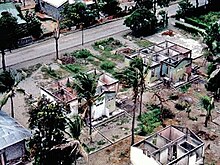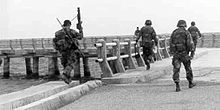Sander Thoenes
Sander Thoenes (born November 7, 1968 in Enschede , Netherlands ; † September 21, 1999 in Becora , Dili , East Timor ) was a Dutch journalist who was shot by Indonesian soldiers during Operation Donner in 1999 .
Life
Thoenes was the youngest of three brothers. In his native Enschede, he attended St. Jacobus high school from 1981 to 1987, where he also worked on the school newspaper t Komkommertje , and studied at Hampshire College in Amherst , Massachusetts , with a scholarship from 1987 to 1990, first fine art, then one further scholarship until 1992 in English literature and modern Russian history. Here he learned to speak the Russian language fluently. In 1990 he worked for one semester as a trainee at the Center for Investigative Reporting in Emeryville , California , and in autumn 1991 as a trainee at US News & World Report in Moscow. Thoenes graduated in August 1992 with the work "Between Glasnost and a Free Press, Soviet Journalism in the Gorbachev years". During his studies he received the John D. and Catherine T. McArthur Award , with which he financed his time in Russia .
After graduating, Thoenes finally moved to Moscow and worked for the English-language newspaper Moscow Times . For the weekly Dutch magazine Vrij Nederland in 1993 he reported on the fighting for the Moscow White House and the chaotic times in post-Soviet Russia. In 1995 he reported from Chechnya , in the same year he was also a correspondent for the US News & World Report . At the end of 1995 Thoenes went to Kazakhstan to work as a correspondent for the Financial Times for a year . During that time he was also responsible for Uzbekistan , Turkmenistan and Afghanistan .
Since he wanted to work next in Indonesia, Thoenes took a course on Indonesian culture, contemporary history and language at the University of Leiden in the first half of 1997 . In September 1997, he moved to Jakarta as Indonesia correspondent for the Financial Times . In two years he not only wrote 608 articles for the newspaper, but also regularly produced articles for the Boston Christian Science Monitor , Vrij Nederland and Radio Deutsche Welle . He also made reports for a program on Indonesian public radio. It was the time of the Asian crisis and the fall of the Indonesian dictator Suharto .
On August 30, 1999, an independence referendum was held in East Timor , in which the majority of the population spoke out in favor of independence from Indonesia, which had occupied the country since 1975. Even before the results were announced on September 4, the last wave of violence broke out by Indonesian security forces and pro-Indonesian militias . Up to 3,000 people were murdered, the infrastructure destroyed and people driven from their homes. On September 15, the adopted United Nations Security Council that Resolution 1264 and sent by Australia led international intervention force INTERFET , to bring the situation back under control. The first units landed in Dili on September 20th. Thoenes was supposed to report on the arrival of the INTERFET in East Timor, after having been in East Timor three weeks earlier.
Thoenes arrived in Dili on a charter flight for journalists on the afternoon of September 21st. He was riding a motorcycle through Becora in southeast Dili with his East Timorese driver Florindo Araújo when they came to a roadblock. When Araújo turned, two Indonesian soldiers of Battalion 745 opened fire. Araújo and Thoenes fell. Araújo managed to escape on foot, but Thoenes was hit but is believed to be still alive. The dead reporter's ears were cut off and parts of the skin on his face peeled off. His body was later found by UN soldiers , dumped in a back garden of a house . One of the two soldiers could later be identified as Lieutenant Camilo dos Santos . The second is believed to be Major Jakob Djoko Sarosa . According to research, Thoenes was only the last of 13 victims killed that day by soldiers of the battalion on their retreat from Laga to the Indonesian West Timor .
consequences
Thoenes was the first foreigner to die after the INTERFET arrived. Two other foreign journalists escaped when their car was ambushed and went into hiding until they were rescued by Australian soldiers. A British reporter who disappeared after the attack by militiamen was also found alive.
Camilo dos Santos and Jakob Djoko Sarosa were indicted on November 6, 2002 in a UN special court in Dili, but since they could not be found, no one has been held accountable for the death of Sander Thoenes to this day.
The Jakarta Foreign Correspondents Club (JFCC) donated a scholarship with the Sander Thoenes Fund . The Financial Times proclaimed a Sander Thoenes Award and Hampshire College also created a Sander Thoenes Research Award .
Web links
- Sander Memorial site
- Trail of murder: Indonesia's bloody retreat , documentary by Step Vaessen (2013)
- Sander Thoenes Research Award
Individual evidence
- ↑ a b c Boris Kester: Sander Thoenes Memorial site - His life , accessed on November 27, 2016.
- ↑ a b c Cameron W. Barr: Battalion 745: A brutal exit , March 13, 2000 , accessed November 27, 2016.
- ↑ a b c d BBC News: UK Journalist killed in East Timor , September 22, 1999 , accessed November 27, 2016.
- ↑ a b Masters of Terror: Lt (Inf) Camilo dos Santos , accessed on November 27, 2016.
- ↑ Al Jazeera: Trail of murder , accessed December 29, 2016.
- ↑ a b "Chapter 7.2 Unlawful Killings and Enforced Disappearances" (PDF; 2.5 MB) from the "Chega!" Report of the CAVR (English)
- ↑ Boris Kester: Sander Thoenes Memorial site - What happened , accessed on November 27, 2016.
- ^ The Jakarta Post: JFCC launches new website , September 9, 2006 ( Memento August 9, 2009 in the Internet Archive ), accessed November 27, 2016.
- ^ The Financial Times: Sander Thoenes Award ( memento November 30, 2011 in the Internet Archive ), accessed November 27, 2016.
- ^ Hampshire College: Sander Thoenes Research Award , accessed November 27, 2016.
| personal data | |
|---|---|
| SURNAME | Thoenes, Sander |
| BRIEF DESCRIPTION | Dutch journalist |
| DATE OF BIRTH | November 7, 1968 |
| PLACE OF BIRTH | Enschede , the Netherlands |
| DATE OF DEATH | September 21, 1999 |
| Place of death | Becora , Dili , East Timor |

